Growth of an Aircraft Industry
The Polikarpov U-2 (or the Po-2 after the death of Polikarpov in 1944) made its first flight on 8 January 1928. A two-seat biplane, it was to become a maid-of-all-work, and particularly an elementary trainer. Thousands of them were built, used even for bombing in the Great Patriotic War, and Nikolai Nikolayevich Polikarpov’s design was an essential factor in the development of Soviet aviation, akin to the role played by Britain’s Tiger Moth and America’s Piper Cub. Production of the PO-2 continued until 1944, and was built in Poland from 1948 until 1953. Produced for 35 years, it was the most popular light aircraft in the Soviet Union.
Of aircraft in the transport category, the ANT (Andrei Nikolayevich Tupolev) series, prefaced by the Models 3 and 4 (see page 19) led to the ANT-9, which first flew on 1 May 1929, and is more fully reviewed on the page opposite. The Kalinin series, already described on page 21, was establishing itself, especially the Model K-5. On 22 December 1930, Andrei Tupolev watched the first flight of his four – engined bomber, the ANT-6, which was put to good use as a transport airplane in 1937 in support of the Polar expeditions (see pages 30-31). Often overlooked, or even ignored by western observers, this was a big aircraft, and no freak, in its time.
Then in 1931, the little Shavrov Sh-2 amphibian and the Stal’2, designed by A. I. Putilov, made their appearance. Of steel construction (Stal is Russian for steel) it could carry four passengers. It first flew on 11 October 1931 from Frunze airfield (Khodinka) in Moscow.
|
AEROFLOT SERVICE AIRCRAFT 1929-35
|
Reorganization
On 29 October 1930, as a feature of the First Five Year Plan of 1928, Dobrolet was replaced by as an all-state airline, a joint- stock company, Grazdansiy Vozduzhniy Flot (G. V.F.). It acquired Ukrvozdukhput (page 16) and developed a domestic hub at Moscow, with passenger services to all important cities, as far east as Irkutsk.
Air Pravda
On 3 June 1930, the first experimental delivery was made of type matrices of the official Pravda newspaper, and on 4 June
The twin-engined PS-9 was the main production version of the ANT-9, (photo: Boris Vdovienko)
1931, it appeared in Kharkov only eleven hours after being type-set in Moscow. On 16 June, a special aviation section was created to ensure matrix delivery to Leningrad, Kharkov, Sevastopol, Pyatagorsk, Grozniy, Odessa, Kazan, Rostov-on- Don, Tiflis, and Sverdlovsk.
A five-engined airliner, the ANT-14, first flew on 14 August 1931. With 36 seats, it was too large for the traffic on airline routes but was used extensively by Pravda for sightseeing and propaganda flights, mainly around Moscow. Only one was built, and its only long-distance foray was to Bucharest; but it carried 40,000 passengers during its ten-year service life, quite an achievement for the time.
Maturity of an Airline
During the 17th Congress of the All-Soviet Communist Party, held in Moscow from 30 January to 4 February 1932, a resolution was passed that "air travel should expand in all directions, as it is one of the important communication links with remote rural regions, and with major industrial centers." On
25 February, Grazdansiy Vozduzhniy Flot (G. V.F.) was reorganized as the Main Directorate of the Civil Aviation Fleet. On
26 March 1932 it was given the trading name of Aeroflot. Aeroflot continued the good work of its predecessors. On
15 December 1933, the final link to the east was completed, by an extension from Irkutsk to Vladivostok (see page 24). Moving up the learning curve, an Aeroflot PS-9 (version of the ANT-9) opened up the first all-Soviet westward route on 31 August 1935, to Prague, Czechoslovakia. The joint Soviet – German airline Deruluft was wound up on 31 March 1937, and in the same year Aeroflot service began from Leningrad to Stockholm, Sweden, in cooperation with A. B.A. The expansion of the Soviet airline was gathering momentum.
|

The only example of the ANT-14, and one of the few five-engined aircraft ever built, (photo: Boris Vdovienko)
|

Wright J6 Whirlwind (3 x 300hp) ■ MTOW 6,000kg (13,2001b) ■ Normal Range 1,000km (620mi) ■ Length 17m (56ft) ■ Span 24m (79ft)


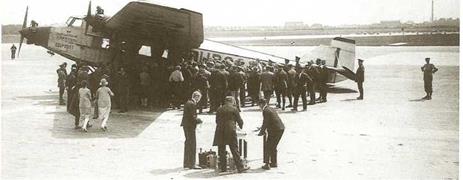
Tupolev Makes His Mark
Andrei Tupolev produced his first multi-engined type, the ANT-9 nine-seat passenger transport, which first flew on 7 May 1929, and was publicly presented in Red Square. It had a metal corrugated fuselage and wing, fixed landing gear, and air-cooled engines, initially Gnome – Rhone Titans. Compared with previous Tupolev designs, it not only looked more elegant and aerodynamically efficient, its performance matched its looks.
Wings of the Soviets
On 10 July 1929, the same day when a common flag was adopted for the civil aviation fleet of the U. S.S. R., Mikhail Gromov took off in the prototype ANT-9, named Krylya Sovyetov (Soviet Wings), on a tour of Europe that included five foreign capital cities. He returned in triumph on 8 August. For the first time, the Soviet Union had an airliner that was possibly the best in Europe. Indeed, there is a report that, calling as it did twice in Berlin, it influenced the Junkers firm to convert the Ju 52 from a single-engined aircraft into a tri-motor. The ANT-9 went into service with Deruluft and Dobrolet early in 1931, initially as a tri-motor with M-26, later U. S. engines. Production of the ANT-9 totaled 75, of which 60 were М-17-powered twins, known as PS-9s, and the type remained in the fleet of Aeroflot until the end of the Second World War.
The tri-motor ANT-9 prototype URSS-309 Krylya Sovyetov (Soviet Wings) at Berlin’s Tempelhof Airport in July 1929, during Mikhail Gromov’s second European tour. Note the three waiters in the foreground preparing champagne for the dignitaries, (photo: Lufthansa)
170 SEATS ■ 770km/h (478mph)
Kuznetsov NK-12M (4 x 12,000ehp) ■ MTOW 175,400kg (385,8001b) ■ Normal Range 8,950km (5,560mi)
  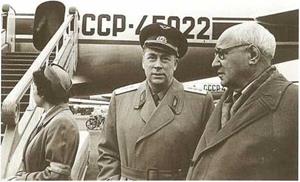
New Lands To Conquer
On 25 March 1963, the Tupolev Tu-114 took over the direct Moscow-Delhi service from the Tu-104 and the 11-18; and on 27 June of that year started service to Conakry, Guinea, with flights extending to Havana, as an alternate route to that via Murmansk. On 19 April 1965, the Conakry service was extended to Accra, Ghana. These were friendly countries, economically dependent on the U. S.S. R., but the following year the Tu-114 made its mark in the capitalist world.
On 4 November 1966, scheduled service began to Montreal, Canada, via Murmansk. The journey time from Moscow was 11V2 hours for the 7,350km (4,568mi) at an average speed of about 640km/h (400mph). Then, on 19 April 1967, after delicate negotiations and demonstration flights, a joint service opened non-stop from Moscow to Tokyo, a distance of 7,488km (4,563mi). This was a remarkable achievement for both Aeroflot and for the Tupolev Design Bureau. For the first time, a Soviet-built aircraft appeared in the markings of a non-communist airline of world stature: Japan Air Lines. The aircraft was flown by the crews of both airlines, and cabin service was provided immaculately by the Japanese carrier.
LONG-RANGE AIRLINERS OF THE LATE 1950s
The Tupolev Tu-114 was deployed on other routes, such as Moscow-Paris and Moscow – Tashkent, but was superseded when the faster and more airport-compatible Ilyushin 11-62 came into domestic service in 1967, and on intercontinental routes in 1968 (see pages 54-55). Every dog, it is said, has his day; and the Tupolev Tu-114, the largest aircraft in the world until the advent of the Boeing 747, was truly a mastiff. Its only fatal accident was at Moscow, on take-off, on 17 February 1966, and this was on a non-scheduled flight.
Andrei Tupolev (right), seen here with Eugene Loginov in front of a Tu-124, at Vnukovo Airport in Moscow in 1962. Loginov was the head of all civil aviation affairs in the Soviet Union at that time, (photo: Boris Vdovienko)
8 SEATS ■ 205km/h (125mph)
|
|
|
The Mi-2 appeared in a wide variety of color schemes depending on its mission. Agricultural sprayers were generally a gloss olive green; Medevac aircraft were red and white; and passenger versions appeared in several variations of orange and blue finishes, one of which is shown here.
|
|

Izotov (2x 400shp) Ш MTOW 3,500kg (7,7001b) Ш Normal Range 240km (148mi) Ш Length 12m(39ft) Ш Rotor Diameter 15m(48ft)

First of the Mils
The Mil Mi-1, of orthodox helicopter design, with a single main rotor and anti-torque rotor mounted on a tail boom, was the first Soviet helicopter to go into series production. As the first of the long line, making its first flight in 1948, it went through the teething troubles of all infants, and its early years were almost in the nature of experimental research. Most Mi-ls had three-bladed rotors, and during the development period, the life of both the blades and the rotor head were considerably improved, while the overhaul of the Ivchenko engines went from TBOs of about 150 up to more than 1,000. They were used mainly by the Soviet Air Force, but Aeroflot began to take delivery in May 1954, using them for agriculture, forest patrol, ambulance, and other aerial work, and occasionally for carrying passengers in mountainous areas.
The Mil Mi-4
Carrying only three passengers besides the pilot, the Mil Mi-l’s work load was limited. By 1952, in response to a specification, directly from the Kremlin, for a larger machine, Mil produced the Mi-4 (there was no Mi-3; and the Mi-2, curiously, came later), in competition with Yakovlev’s Yak-24 design. It too had early problems, but necessity was the mother of invention. Four-blad – ed rotors made from a steel tube/wooden rib/plywood-and-fabric combination gave way to allmetal construction, including honeycomb sections. Magnesium corrosion led to replacement by aluminum parts. But when all was done, a good aircraft emerged and, as noted on the opposite page, the Mi-4 had the honor to open the first regularly scheduled helicopter airline service in the Soviet Union, carrying between eight and eleven passengers on each flight.
The Mil Mi-2
Mikhail Mil had already taken advantage of the light weight of turbine engines when he produced the Mil Mi-6, world’s largest helicopter at the time, in the autumn of 1957. He then turned his attention to sharpening the performance of the smaller craft. In essence, he used two smaller and lighter turbine engines to make a new version of the Mi-1. By placing the engines above the fuselage, there was room enough for eight passengers. This was almost as much as the larger Mil Mi-4 could carry, so that essentially the Mil Mi-2 was able to replace both of the older types.
True, the passenger cabin was a little more cramped. The Mi-2’s 4.47m (14ft 8in) length was a foot longer than the Mi-4’s; but its 1.2m (4ft) width and 1.4m (4ft 7in) height were almost two feet narrower and more than a foot shorter, respectively. But this did not seem to matter, as helicopter journeys are invariably of short duration, and the clientele does not need either to stand up or to move about.
Equally, the Mi-2’s range was inferior to that of both predecessors; but this could be improved by supplementary tanks, if necessary. In compensation, the Mi-2’s speed was 25 percent more than the Mi-4’s and 50 percent more than the Mi-l’s.
Rotor-blade technology was impressive. Of bonded construction entirely, the three-bladed main rotor was equipped with leading-edge electro-thermal de-icing, with a 2,000-hour or more life. The anti-torque tail rotor had only two blades. Altogether, the Mil Mi-2 emerged as a thoroughly reliable, modern aircraft of advanced construction, and it took its place in Aeroflot’s inventory from 1967 onwards as a standard type which has stood the acid test of time and stringent operational conditions.
|
THE SMALLER MIL HELICOPTERS
|
First
Flight
Date
|
First
Aeroflot
Service
|
Aircraft
Type
|
Dimensions-m(ft)
|
Speed
km/h
(mph)
|
Seats
|
MTOW
kg
(lb)
|
Normal Range km (mi)
|
No.
Built
|
|
Fuselage
Length
|
Rotor
Diam.
|
|
Sep
1948
|
May
1954
|
Mi-1
|
12.1
(39.9)
|
14.5
(47.7)
|
135
(73)
|
3
|
2.500
(5,500)
|
350
(180)
|
2,000?
|
|
Aug
|
1954
|
Mi-4
|
17.8
|
21.0
|
160
|
8-11
|
7,350
|
520
|
3,500+
|
|
1952
|
|
|
(55.1)
|
(68.111
|
(86)
|
|
(16,200)
|
(320)
|
|
|
1961
|
1967
|
Mi-2
|
11.9
|
14.5
|
205
|
8
|
3,500
|
240
|
2,800+
|
|
|
|
(39.2)
|
(47.7)
|
(127)
|
|
(7,715)
|
(145)
|
|
|

The Beginning
Throughout the history of the Soviet Union, the extension of the railroad system has always been a constant economic objective, to provide the logistics connection between the sources of wealth, particularly mineral wealth, and especially in the far reaches of the Asian territories. Gradually, branches of line sprouted from the Trans-Siberian Railway, often linking it with northerly ports on the great rivers, the Ob, the Yenesei, and the Lena. Of these, the most remote was the Lena, whose source is close to Lake Baikal, but which flows northeast through what was, until recently, largely uncharted territory.
By 1950, a line had reached Bratsk, site of a huge hydroelectric station under construction, and during the next decade, this was extended to Ust’ Kut, on the Lena. For the first time, albeit only during the May-October summer season, when the Lena was ice-free, the historic trading center of Yakutsk, surrounded by newly-established satellite mining sites of great wealth, was linked with Moscow by a modem surface transport system.
Birth of the BAM
On 8 July 1974, the Supreme Soviet officially declared the creation of a railroad construction program of great magnitude. The Baikal-Amur Magistral (Main Line, or Artery), or the BAM, was to parallel the Trans-Siberian Railway over about 3,500km (2,200mi) of its eastern length. This action took place at a time when relations between the Soviet Union and China were cool, and the BAM was widely perceived as a defensive measure against the possible cutting of the TransSib by an attacking force. But the BAM also opened up vast possibilities for improving the access to the riches of Siberian mineral wealth.
Preliminary surveys had started on 30 April 1974, using Mil Mi-2 and Mi-8 helicopters. But progress at first was handicapped by the onset of an early winter — in August! Housing for the workers was incomplete, and one of the first tasks for the growing armada of supporting aircraft was to bring 2,500 tons of heating equipment to the first construction sites. The first workers arrived on the Ulkan River on 28
October 1974, and in the following year, in a Soviet equivalent of “Go West Young Man," teams of Komsomol (Young Communist Workers League) headed east in their thousands.
Rail-Air Cooperation
Aviation, including the resources of Aeroflot, supported BAM during the entire period of its construction, with mainline connections to cities on the trans-Siberian Railway, and countless sorties by feeder aircraft, fixed wing and rotary wing. Other than the 3,500km (2,175mi) of track, the mainly Komsomol teams built 2,237 bridges, established 60 cities, some of them now large centers, as well as many villages. Hundreds of thousands of passenger flights were made, and supplies for the 22 special construction trains and 37 mechanized columns, and the hundreds of bridging and tunneling units, were carried largely by air, until the BAM line was progressively completed.


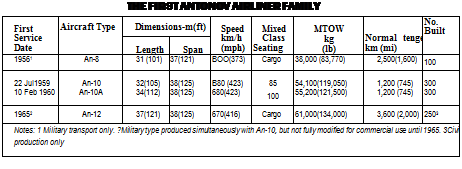


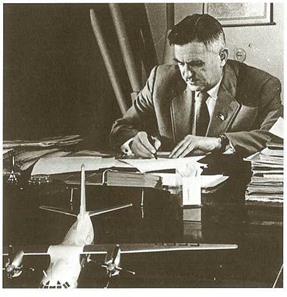

















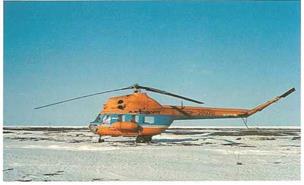



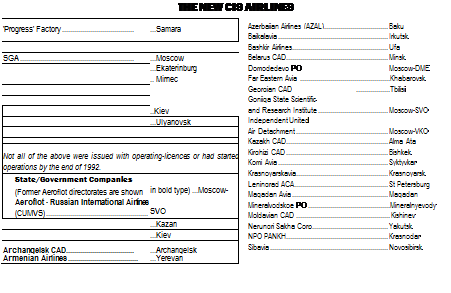
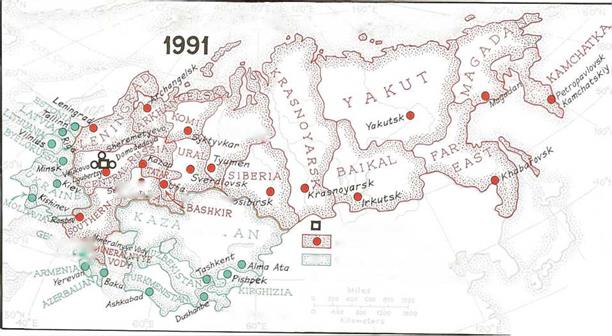

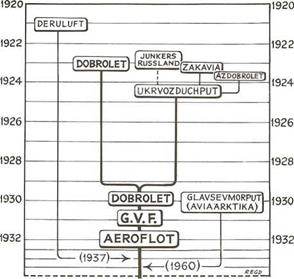
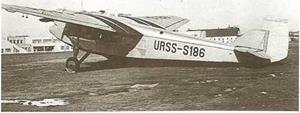














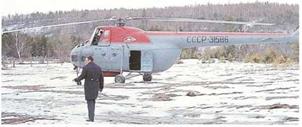


 St Petersburg (Leningrad), is connected to Moscow by a good railway service, with future high-speed rail potential.
St Petersburg (Leningrad), is connected to Moscow by a good railway service, with future high-speed rail potential.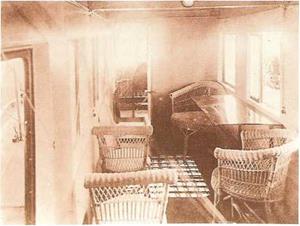
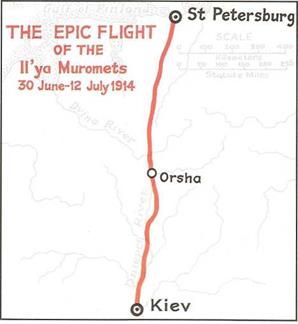

 6 SEATS ■ 80km/h (50mph)
6 SEATS ■ 80km/h (50mph)




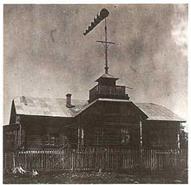
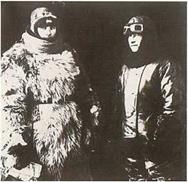
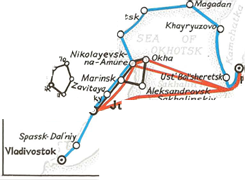

 Wright Cyclone GR-1820-G2 (4 x 850hp) ■ MTOW 28,100kg (62,0001b) ■ Normal Range 2,000km (l,200mi) ■ Length 28m (92ft) ■ Span 48m (157ft)
Wright Cyclone GR-1820-G2 (4 x 850hp) ■ MTOW 28,100kg (62,0001b) ■ Normal Range 2,000km (l,200mi) ■ Length 28m (92ft) ■ Span 48m (157ft)





